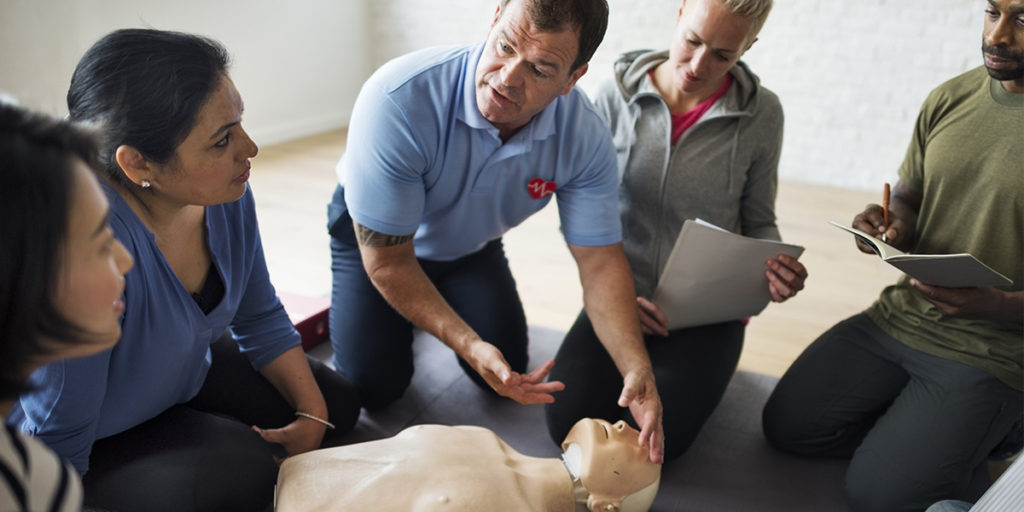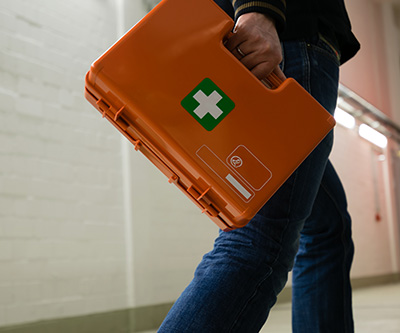First Aid
Posted: Jan. 28, 2020 • By Kevin Kohler

First Aid is just taking care of cuts and scrapes isn’t it?
No, it goes well beyond that. The Canadian Centre for Occupational Health and Safety (CCOHS) defines first aid as:
“…. emergency care given immediately to an injured person. The purpose of first aid is to minimize injury and future disability. In serious cases, first aid may be necessary to keep the victim alive.“
This level of care means being well prepared for the types of medical emergencies that could conceivably occur at your workplace.
What can we do until emergency responders arrive?

Even with limited knowledge of first aid you can save a life. Consider this CBC news report from February 2018:
A distraught wife … saved her husband’s life with 20 exhausting minutes of chest compressions ….
The active couple are kayak racers who had just come in from a paddle and hopped in the hot tub to warm up. Shortly after they got out, 64-year-old Ken said he wasn’t feeling well. “He goes down on his knees and next thing I know he’s collapsed…
… Despite not having any first aid training she managed to perform CPR … with the help of (a) 911 dispatcher … And 19 long minutes later, paramedics arrived to take over. Ken has made a “miraculous” recovery according to nurses who assisted the couple at Royal Jubilee Hospital in Victoria ….
Now trained in first aid and CPR, Katz has inspired many of her friends to take life-saving courses …
Being better prepared might have made this “save” less stressful but having the presence of mind to seek assistance from a knowledgeable first aider and commit to the process was just as important. Having trained first aid providers readily accessible at work can mean the difference between life and death.
We have a first aid kit and I think that someone has training.
First aid is not a guessing matter. In Canada every province, territory and federal workplace has its own first aid requirements under the prevailing OHS legislation. The legislation generally stipulates the number of first aiders who must be present, their level of training, how they are to be summoned and the first aid kits, equipment and/or facilities that must be provided. Similar legislation exists under OSHA or individual state programs in the U.S.
Legislated first aid requirements are based on:
- The hazards and type of work being performed
- The distance from a medical treatment facility and emergency medical transportation
- The number of employees who are present
Medical Emergency Response Plan (ERP)

Your first aid program should be part of a comprehensive medical emergency plan. To determine the types of medical emergencies that you might be faced with, you should conduct a hazard and risk assessment for each work location and type of work performed. Some injuries that you may need to be prepared to provide first aid treatment for may include:
- Burns from chemicals or heat
- Electrocution and arc flash
- Eye injuries
- Severe trauma and internal and external bleeding
- Heart attacks, choking and seizures
- Heat stroke, frostbite, hypothermia
A plan should be developed and training provided for each potential medical emergency. It is important to integrate this plan with your existing ERPs so that injured workers can be safely evacuated. You must consider how you will treat and evacuate injured workers with disabilities or special needs.
Regardless of your legislated requirements you have a general duty to protect workers and be prepared for the medical emergencies that you could encounter. Effective first aid plans protect workers and demonstrate your commitment to a safe and healthy workplace.
Related Articles

Emergency Response Planning
Emergency Response Plan (ERP) An emergency response plan (ERP) is a written description of the actions, in the order in […]
Read Article
Ground Disturbance
Can ground disturbance be dangerous? 40 years ago on March 2nd 1979 an excavation contractor working in a new Edmonton, […]
Read Article